Legal innovation is pyrexial
Legal innovation is pyrexial, the tempo fever is at fever pitch. Ron Friedmann provides evidence and explains why he thinks it’s happening.
My views here will be tested and perhaps changed by the ILTACON 2019 conference workshop on 20 August 2019 in Orlando, FL. I will co-lead, with Cheryl Disch (Duane Morris) and Joshua Fireman (Fireman & Company), an interactive workshop focused on practical innovation and how organizations can better develop and vet ideas, and then move from idea to execution.
This post uses slides I created in June for presentations to a group of large NYC law firms and to a session at the American Association of Law Libraries (AALL) annual conference. (For more on my AALL presentation, see my LAC Group blog post, AALL 2019 and legal innovation.)
My views here will be tested and perhaps changed by an upcoming ILTACON 2019 conference workshop on 20 August 2019 in Orlando, FL. I will co-lead, with Cheryl Disch (Duane Morris) and Joshua Fireman (Fireman & Company), an interactive workshop focused on practical innovation and how organizations can better develop and vet ideas, and then move from idea to execution. I hope some readers will attend this session.
This post uses slides I created in June for presentations to a group of large NYC law firms and to a session at the American Association of Law Libraries (AALL) annual conference. (For more on my AALL presentation, see my LAC Group blog post, AALL 2019 and legal innovation.)
Logo Mania (Fever Symptom 1)
This sampling shows logos of law-firm-branded innovation initiatives. It does not include all such logos and plenty of firms invest in innovation without creating a logo.
We can debate the definition of innovation. We can argue how many law firms are “really doing innovation versus issuing press releases”. And can wonder what impact innovation has. We can all agree, however, that three years ago, this list would have been much shorter.
Headlines Galore (Fever Symptom 2)
More anecdata supporting the innovation fever…
A few years ago, we would not have seen so many headlines in six months.
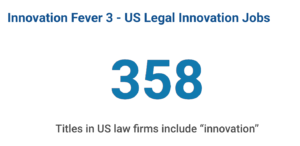 A Job for Everyone? (Fever Symptom 3)
A Job for Everyone? (Fever Symptom 3)
Again, the result even 3 years ago would have been way lower. (I searched LinkedIn for the legal market and innovation in the title in June 2019 – your mileage may vary.)
Why Now? (Fever Diagnosis)
Flat Growth. In aggregate, the Am Law 100 have experienced little growth since the 2008 crash. Revenue growth mainly reflects rising rates. Demand for legal services has grown but corporations fulfill it by hiring more in-house counsel instead of buying more from firms.
Drive for Value. With flat demand, clients have more buying power. And they use that power to pressure firms to deliver more value. I see evidence that they use law firm innovation as a proxy for value. And this works out nicely for law firm management: starting an innovation initiative is way easier than delivering value by changing how lawyers work or the firm’s billable hour business model.
Segment Competition. Also driving innovation is intense competition within peer groups of firms. Once one firm in a peer group announces innovation, others feel compelled to follow. Query whether, with all the announcements, clients distinguish between “innovation by press release” and innovation that changes how lawyers work to reduce cost or improve outcomes.
Substitutes. Many commentators say that firms outside the very top ones are losing business to alternative legal service providers (ALSP), which advertise how they are far more “tech enabled” than law firms. I see less threat from ALSP but their rise may also spur innovation.
Peer Pressure. And finally, do not discount emotion. Partners at large firms face internal and external peer pressure. When partners read the trade press or hear from friends about innovation, they can develop a sense that “if other firms are doing innovation, we need to do it too”
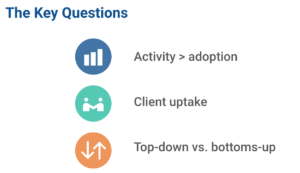 Key Innovation Questions (Fever Treatment 1)
Key Innovation Questions (Fever Treatment 1)
Activity vs. Adoption. Innovation talk exceeds adoption and results. Consider what well-known economist Erik Brynjolfsson said early in the tech revolution: “You can see the computer age everywhere but in the productivity statistics.” For all the innovation initiatives, query how much impact that has had on lawyer output per hour or improved outcomes.
Client Uptake. Clients have no clear way to gauge the value they get from firms (see innovation as proxy above). Moreover, most in-house counsel work with fewer resources than outside counsel. As cost centers, corporate law departments lack resources to improve processes or deploy leading edge legal tech. Most work with cruder tools than their outside counsel. Without good metrics and without relevant personal experience, they cannot easily judge law firm efforts. And even if they can, how often do they drop outside experts for inefficiency?
The Best Path to Innovation? An open question remains what drives the best result: top down, central innovation efforts or bottoms-up, practice-driven ones. In my opinion, for innovation to have impact, it must originate from practices and have institutional support.
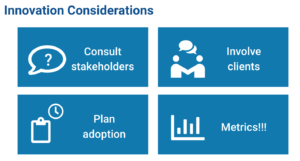 Key Innovation Considerations (Fever Treatment 2)
Key Innovation Considerations (Fever Treatment 2)
If our ultimate goal is to IMPROVE PRACTICE, how do we get there? We must recognize that innovation is only a means to an end. For innovation to change practice, several ingredients must come together:
- Consult stakeholders – learn their requirements and receptivity to change before assuming they will change how they work.
- Involve clients – Clients have the most influence over partners. Their support for a law firm innovation initiative likely is the best way to get support and success.
- Plan Adoption – Neither tech nor innovation is a magic wand. The only way to ensure practice improvement is the to plan changes carefully, including extensive adoption measures. Change does not happen by itself.
- Develop metrics – This may be the holy grail but if firms can show improved efficiency, better client value, or perhaps most importantly, higher margins… that will motivate change… and investment in more change.
Conclusion
Innovation fever shows no sign of breaking. We must work to harness the heat generated to change how lawyers practice. Absent a change in practice, a change that generates value for clients and margin for law firms, what good is innovation?
Author

Ron Friedmann, a lawyer, has spent three decades improving law practice efficiency and law firm business operations. He is Chief Knowledge + Information Officer at LAC Group.
He is a Fellow and former Trustee of the College of Law Practice Management and speaks and writes regularly.
Legal innovation is pyrexial was first published as Legal Innovation Fever on Ron’s PRISM blog on July 28, 2019.



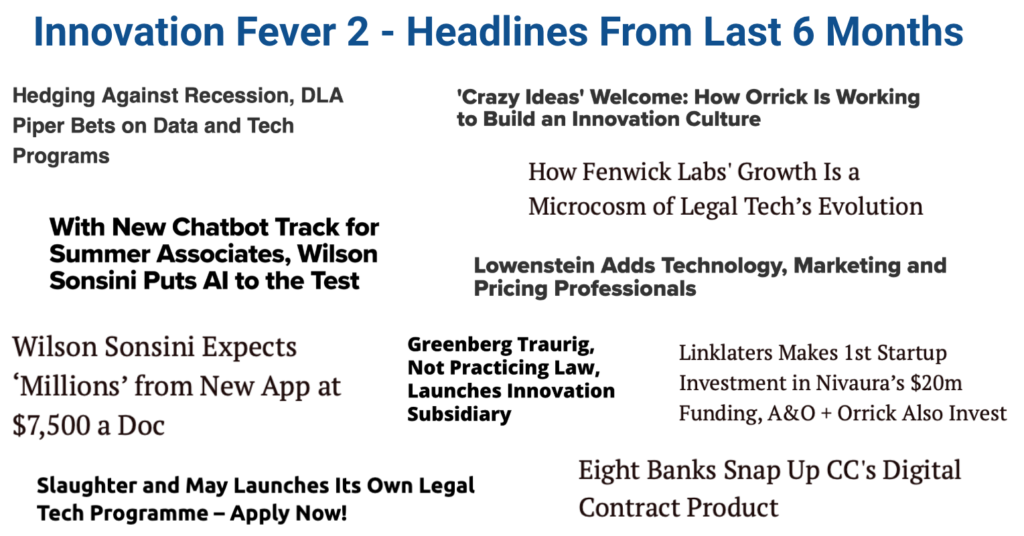
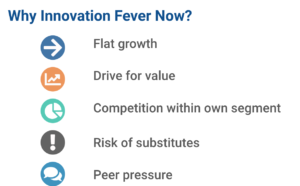
Leave a Reply